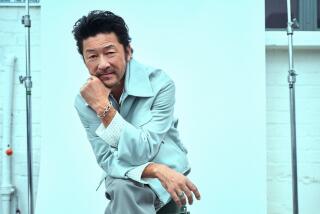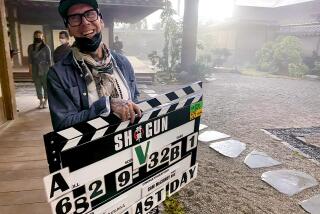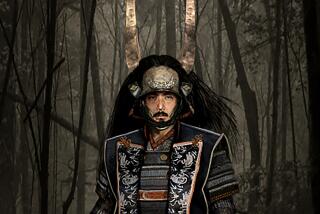Why Akira Kurosawa’s ‘Seven Samurai’ keeps inspiring new retellings like ‘The Magnificent Seven’
- Share via
The plot of director Akira Kurosawa’s 1954 classic, “Seven Samurai,” can be summed up in one sentence: Mercenaries are hired to protect a farming village from marauding bandits. Yet within that simple framework is a rich tale involving self-sacrifice, honor, male bonding and sympathy for the underdog. And that’s why Kurosawa’s masterpiece continues to inspire filmmakers and other artists.
“It’s classic mythology, it’s the hero’s journey, and it’s about the best of us coming together for one cause, to do the right thing,” says Antoine Fuqua, director of the recently opened “The Magnificent Seven,” the latest screen version of the “Samurai” tale.
Fuqua’s film stars Denzel Washington and Chris Pratt as gunmen leading a gang of mercenaries — a multiracial group that includes a Mexican, Asian and Native American — against a rapacious mine owner (Peter Sarsgaard) terrorizing a Western town. It is not just a rethinking of the 1960 movie of the same name — which was a western remake of “Seven Samurai” and featured Yul Brynner, Steve McQueen and Charles Bronson saving a Mexican village from bandit leader Eli Wallach — but the latest example of the Kurosawa work’s influence.
All three films, says Fuqua, involve “the classic question of who we are as human beings. Do we step up to the plate when the time comes? The question is: When do you put your life on the line for the right reasons? And it’s not for your family, it’s for people you don’t even know.”

“The Magnificent Seven” trailer.
Writer-director John Sayles believes that one of the main attractions of the story is that it is anti-cynical.
“Mercenaries are meant to be the ultimate cynics, sometimes changing sides in the middle of the fight if they get a better offer,” said Sayles, who wrote the screenplay for the 1980 film “Battle Beyond the Stars,” which sets the “Seven Samurai” story in outer space. “People like the concept of honor; they like to root for underdogs,” he adds, “and the tensions between the mercenaries and the villagers makes for good personal drama.”
In fact, the 1954 original, which was set in 16th century Japan, has, in its own way, proven to be the gift that keeps on giving — it has spawned five “Magnificent Seven” films; an anime series; a TV series; martial arts, sci-fi, Bollywood and gladiator spinoffs; a video game; and is even a key element in “The Last Samurai,” a critically acclaimed novel by Helen Dewitt in which a single mother screens the film for her son in order to familiarize him with male role models. The film has also been referenced in numerous Westerns, such as “The Big Gundown,” a 1966 spaghetti Western starring Lee Van Cleef in which one of the main characters is based on actor Toshiro Mifune’s role in “Seven Samurai.”
“It’s classic mythology, it’s the hero’s journey, and it’s about the best of us coming together for one cause, to do the right thing.”
— Antoine Fuqua, director of “The Magnificent Seven”
Richard D. Pepperman, author of “Everything I Know About Filmmaking I Learned Watching Seven Samurai,” notes that thanks to the original film’s editing, camera movement and startlingly realistic action sequences, it “has a more modern look compared to the films of the era. And it’s [Kurosawa’s] understanding that film somehow holds a sense of spontaneity that no other art form does quite as well.”
Kurosawa was, in fact, long regarded as the most “western” of Japanese filmmakers, one of his early influences being the cowboy pictures of director John Ford. “Good westerns are liked by everyone,” he once said. “Westerns have been done over and over again, and in the process a kind of grammar has evolved. I have learned from this grammar of the western.”
It’s no surprise, then, that several of Kurosawa’s Japanese period dramas have been remade as westerns. In addition to “Seven Samurai,” his 1950 film “Rashomon” was reconfigured as the 1964 Paul Newman film “The Outrage,” and 1961’s “Yojimbo” became the Sergio Leone classic “A Fistful of Dollars” (Kurosawa’s 1958 film, “The Hidden Fortress,” was also a major influence on “Star Wars.”)
See the most-read stories in Entertainment this hour »
Walter Mirisch, executive producer of both the 1960 and current versions of “The Magnificent Seven,” says that after seeing the Kurosawa original, “it occurred to me that this was very easily translatable into an American western. It’s about a group of men who are commissioned to save a town, and that’s a premise that’s been used frequently in American westerns.”
There is also a social consciousness in these films, particularly “Seven Samurai,” that continues to resonate and feel very modern. Helen DeWitt, author of “The Last Samurai,” says that the men who decide “to come and help, they are not completely immune to the prejudices that see this peasant class as lowly; they are able to get beyond that. It’s the acceptance that these oppressed people have some kind of claim to compassion. It’s not about thinking peasants are noble, but simply acknowledging they have the right not to be plundered. Simply deciding that is a moral breakthrough.”
And there’s this. Like “The Odd Couple,” which can be rejiggered to fit any sexual combination, race or social setting, the universality of Kurosawa’s simple concept opens up endless possibilities. Mercenaries saving a village from Islamic State? Good guys going after a motorcycle gang terrorizing a small town? Why not?
“These guys could be knights, they could be cops, guys on the streets today,” says director Fuqua. “Any concept of going in to help people who can’t help themselves, you can do.”
Says Mirisch: “There are oppressed people everywhere, and we feel deeply for them. You can drop men like the ‘Seven Samurai’ anywhere and have them come to the aid of those people who need the assistance of experts.”
More to Read
Only good movies
Get the Indie Focus newsletter, Mark Olsen's weekly guide to the world of cinema.
You may occasionally receive promotional content from the Los Angeles Times.










